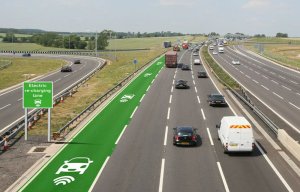The Migration to Electric Transportation Has Many Faces

We’re all aware of steady development of better and lower-cost batteries, which seems to be the putative victor here. Once affordable batteries provide a range of 350 miles, and we’re fairly close to that, the game will be over, and petroleum-powered cars and light trucks will be obsolete in very short order.
An interesting but failed attempt at a different paradigm was represented by Project Better Place, whose concept was to set up battery-swapping stations all over our roadways at which drivers could swap discharged batteries for freshly charged ones. Although this would have been an excellent solution in small, densely populated countries like Israel, it was clearly the wrong tool for the job here in the U.S., with our 3.5 million square miles in the contiguous 48 states.
That, of course, is one of the concepts that makes hydrogen a non-starter, i.e., retrofitting an enormous landmass with a new fuel delivery infrastructure. The idea here, however, is noteworthy, which is why I refer to it as a different paradigm: our thinking of transportation solutions can be blinded by the ancient concept of a gas-tank; it takes work and imagination to realize that power source doesn’t have to be carried along with the vehicle.
A variation on this second theme is to build inductive chargers into our vehicles and power them with electricity that runs in the roadways. Here’s such a project underway in Australia, which has the advantage of the densely packed population; though the land mass is huge, more than 80% lives on the country’s Eastern Coast.
Having said that, it’s hard to imagine that this will work, especially given the enormous chicken-and-egg issue: until EVs are ubiquitous (probably at least a couple of decades), the value of such roadways, which are extremely expensive to build and operate, will be largely under-realized.
In any case, it’s good to know that humankind is working hard to find solutions to its environmental challenges. Cheers to the Aussies, and best of luck.

Hi Craig,
You are quite correct when you say the key to greater adoption of Electric cars is “affordable batteries with a range of 350 miles”, I would add these batteries (or ESD’s)must also be very fast charging, 5 minutes at most.
However, I’d like to take the opportunity to correct a few popular misconceptions of yours. (please don’t take this criticism, but this is an area where if spent a lot of time money in learning over the last 20 years).
I also hope you don’t mind me helping you understand the media, and people not really connected with the EV industry, persist in repeating myths and misconceptions.
1) Hydrogen is not “a non-starter, because of the difficulty retrofitting an enormous landmass with new fuel delivery infrastructure” !
That task is easily and affordable. In fact, companies like Shell would be only to eager to roll out new infrastructure. Shell believes an infrastructure roll out would be profitable before selling the first Kilo of H2 !
2) I’ve never really been sure whether Better Place was a scam from the start, or just a case of an over enthusiastic delusion that turned into a $2 billion scam.
The concept (borrowed from a 1950’s ‘Popular Science” type magazine was always obviously unworkable in real life. The entire product and it’s claims were always impracticable and absurdly idealistic.
Yet a lot of, otherwise astute, investors sank money into this absurdity !
Even Thornley a senior Australian Labour party politician and early IT multi-millionaire, not only invested heavily himself and became the company’s CEO, but persuaded the Australian Labour government to invest taxpayer money into Better Place.
Luckily, the only reason Evan Thornley didn’t extract $20 million from my home town motoring organization, was my organized opposition.
Better Place was never workable, not in Israel, not anywhere !
3)Electric Super Highway: Australia’s Ambitious Electric Dream !
Another absurd scheme proposed by a State Labour government !
Contrary to the over excited headline, this is a Queensland, not Australian, proposal.
It will never be built ! Oh, a few lonely, unused, conventional plug-in charging posts may be erected, but the rest will never happen.
Even for Labour, the proposal’s pretty daft ! Queensland is an enormous state, sparsely populated with only a handful of EV’s, most of which are just curios.
Since neither the Federal government or the State governments offer any incentives, and no imported EV’s have inductive charging technology, the idea of an inductive charging highway is pretty far fetched.
Then there’s the issue of road safety. Neither the Federal government, nor the police would be happy to lose one very expensive lane only to create a traffic hazard caused by a handful of vehicles.
But then, as the Acting Minister Steven Miles points out, the super highway is not a firm proposal. In reality, what will really happen is some conventional charging posts will be installed in 18 towns.
The government will contribute $1 million to the $3 million project. (That’s when the astute reader should realize they’ve been hyped ! $ 3 million, doesn’t buy much charging infrastructure).
4) Don’t get me wrong, I love your optimism ! However, the problems facing EV adoption are mostly those of inadequate technology. EV’s will not become “ubiquitous” until a ‘breakthrough’ occurs with ESD, that may take longer than 20 years.
I really don’t want to be a wet blanket on your enthusiasm, but like most people, I ‘ve grown weary of all the hype and false optimism that’s plagued EV progress.
It’s counter-productive.